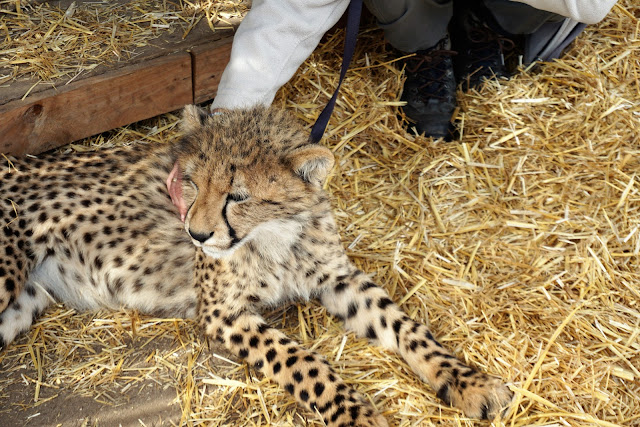Exhausted from 30+ hours of traveling, we nevertheless jumped (okay, crawled) into our rental car and headed down the wrong side of the road (for us) to our first South African destination: Cheetah Outreach, a somewhat controversial plot of land outside of Cape Town.
The goal of Cheetah Outreach seems obvious--to educate the public and to preserve, protect, and increase the cheetah population, which has dwindled from 100,000 in the early 20th century to a mere 6,000 living in the wild today.
The controversy arises from the breeding of cheetahs to be used as "ambassador animals" that are never introduced into the wild, and from the fact that people who pay the entrance fee are allowed to touch the animals. This "hands-on" practice is getting increasingly taboo in the animal rights world.
We were blissfully unaware of the controversy when we planned our trip, but I have to say that I didn't like seeing speedy cheetahs on leashes:
We were allowed, one at a time, to enter the enclosure with these sleeping kitties and to pet them on their sides. Most of the people who work here are volunteers, and they come from all over the world.
Cheetah Outreach has 12 male adult cheetahs, all of which are captive-bred and hand-reared. Eight of them are rotated as "ambassadors" at this facility and are "hired out" for events.
Of course we posed for a picture, and we even bought this one for a few dollars:
My photo of the photo, cropped, isn't too bad:
There are a few other animals kept in large pens at Cheetah Outreach, including these cute meerkats:
There were several small mountain tortoises that were about as big around as a tennis ball:
Luckily, a nice caretaker saw that I was having problems. He took my camera inside and snapped several photos for me.
. . . and this is an orange trumpet creeper:
Time to move on to our next destination: the Kirstenbosch Gardens, but first I have to include this interesting photo of a scene across the street from the parking lot: a building under construction with a huge head in the foreground and a man sitting on the statue base and chatting on his phone. I don't know what it is about the combination, but at the time it struck me as hilariously funny. That's what no sleep does to me:
We made our way back to the city and towards Table Mountain:


























Despite the controversy, I think organizations like cheetah outreach are invaluable. After a visit to see a cheetah, and to touch it, you care more about it. Cheetahs need people to care. I would much rather see them in the wild, but it is much more expensive, time consuming and less odds of seeing one if you go that direction. Same with zoos.
ReplyDelete